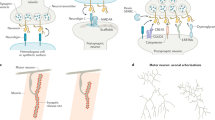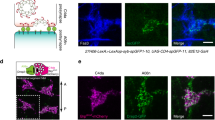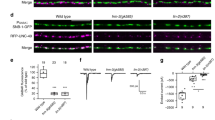Abstract
Although WNTs have been long thought of as regulators of cell fate, recent studies highlight their involvement in crucial aspects of synaptic development in the nervous system. Particularly compelling are recent studies of the neuromuscular junction in nematodes, insects, fish and mammals. These studies place WNTs as major determinants of synapse differentiation and neurotransmitter receptor clustering.
This is a preview of subscription content, access via your institution
Access options
Subscribe to this journal
Receive 12 print issues and online access
$189.00 per year
only $15.75 per issue
Buy this article
- Purchase on Springer Link
- Instant access to full article PDF
Prices may be subject to local taxes which are calculated during checkout



Similar content being viewed by others
References
Siegfried, E. & Perrimon, N. Drosophila wingless: a paradigm for the function and mechanism of Wnt signaling. Bioessays 16, 395–404 (1994).
Gould, T. D. & Manji, H. K. The Wnt signaling pathway in bipolar disorder. Neuroscientist 8, 497–511 (2002).
De Ferrari, G. V. & Inestrosa, N. C. Wnt signaling function in Alzheimer's disease. Brain Res. Brain Res. Rev. 33, 1–12 (2000).
Caricasole, A. et al. Two sides of the same coin: Wnt signaling in neurodegeneration and neuro-oncology. Biosci. Rep. 25, 309–327 (2005).
Inestrosa, N. et al. Wnt signaling involvement in β-amyloid-dependent neurodegeneration. Neurochem. Int. 41, 341–344 (2002).
Johnson, M. L. & Rajamannan, N. Diseases of Wnt signaling. Rev. Endocr. Metab. Disord. 7, 41–49 (2006).
Speese, S. D. & Budnik, V. Wnts: up-and-coming at the synapse. Trends Neurosci. 30, 268–275 (2007).
Salinas, P. C. & Zou, Y. Wnt signaling in neural circuit assembly. Annu. Rev. Neurosci. 31, 339–358 (2008).
Song, Y. & Balice-Gordon, R. New dogs in the dogma: Lrp4 and Tid1 in neuromuscular synapse formation. Neuron 60, 526–528 (2008).
Widelitz, R. Wnt signaling through canonical and non-canonical pathways: recent progress. Growth Factors 23, 111–116 (2005).
Lucas, F. R. & Salinas, P. C. WNT-7a induces axonal remodeling and increases synapsin I levels in cerebellar neurons. Dev. Biol. 192, 31–44 (1997).
Krylova, O. et al. WNT-3, expressed by motoneurons, regulates terminal arborization of neurotrophin-3-responsive spinal sensory neurons. Neuron 35, 1043–1056 (2002).
Rosso, S. B., Sussman, D., Wynshaw-Boris, A. & Salinas, P. C. Wnt signaling through Dishevelled, Rac and JNK regulates dendritic development. Nature Neurosci. 8, 34–42 (2005).
Kummer, T. T., Misgeld, T. & Sanes, J. R. Assembly of the postsynaptic membrane at the neuromuscular junction: paradigm lost. Curr. Opin. Neurobiol. 16, 74–82 (2006).
Schaeffer, L., de Kerchove d'Exaerde, A. & Changeux, J. P. Targeting transcription to the neuromuscular synapse. Neuron 31, 15–22 (2001).
Sanes, J. R. & Lichtman, J. W. Induction, assembly, maturation and maintenance of a postsynaptic apparatus. Nature Rev. Neurosci. 2, 791–805 (2001).
Misgeld, T. et al. Roles of neurotransmitter in synapse formation: development of neuromuscular junctions lacking choline acetyltransferase. Neuron 36, 635–648 (2002).
Weston, C., Yee, B., Hod, E. & Prives, J. Agrin-induced acetylcholine receptor clustering is mediated by the small guanosine triphosphatases Rac and Cdc42. J. Cell Biol. 150, 205–212 (2000).
Weston, C. et al. Cooperative regulation by Rac and Rho of agrin-induced acetylcholine receptor clustering in muscle cells. J. Biol. Chem. 278, 6450–6455 (2003).
Kim, N. & Burden, S. J. MuSK controls where motor axons grow and form synapses. Nature Neurosci. 11, 19–27 (2008).
Lefebvre, J. L., Jing, L., Becaficco, S., Franzini-Armstrong, C. & Granato, M. Differential requirement for MuSK and dystroglycan in generating patterns of neuromuscular innervation. Proc. Natl Acad. Sci. USA 104, 2483–2488 (2007).
Lin, W. et al. Distinct roles of nerve and muscle in postsynaptic differentiation of the neuromuscular synapse. Nature 410, 1057–1064 (2001).
Yang, X. et al. Patterning of muscle acetylcholine receptor gene expression in of motor innervation. Neuron 30, 399–410 (2001).
Bezakova, G., Rabben, I., Sefland, I., Fumagalli, G. & Lomo, T. Neural agrin controls acetylcholine receptor stability in skeletal muscle fibers. Proc. Natl Acad. Sci. USA 98, 9924–9929 (2001).
Luo, Z. G. et al. Regulation of AChR clustering by Dishevelled interacting with MuSK and PAK1. Neuron 35, 489–505 (2002).
Kim, C. H., Xiong, W. C. & Mei, L. Regulation of MuSK expression by a novel signaling pathway. J. Biol. Chem. 278, 38522–38527 (2003).
Wang, J. et al. Wnt/β-catenin signaling suppresses Rapsyn expression and inhibits acetylcholine receptor clustering at the neuromuscular junction. J. Biol. Chem. 283, 21668–21675 (2008).
Henriquez, J. P. et al. Wnt signaling promotes AChR aggregation at the neuromuscular synapse in collaboration with agrin. Proc. Natl Acad. Sci. USA 105, 18812–18817 (2008).
Jing, L., Lefebvre, J. L., Gordon, L. R. & Granato, M. Wnt signals organize synaptic prepattern and axon guidance through the zebrafish unplugged/MuSK receptor. Neuron 61, 721–733 (2009).
Castelo-Branco, G. et al. Ventral midbrain glia express region-specific transcription factors and regulate dopaminergic neurogenesis through Wnt-5a secretion. Mol. Cell Neurosci. 31, 251–262 (2006).
Hooper, J. E. Distinct pathways for autocrine and paracrine Wingless signalling in Drosophila embryos. Nature 372, 461–464 (1994).
Li, X. M. et al. Retrograde regulation of motoneuron differentiation by muscle beta-catenin. Nature Neurosci. 11, 262–268 (2008).
Wang, J. & LUO, Z.-G. The role of Wnt/ß-catenin signaling in postsynaptic differentiation. Commun. Integr. Biol. 1, 1–3 (2008).
Zhang, B. et al. Beta-catenin regulates acetylcholine receptor clustering in muscle cells through interaction with rapsyn. J. Neurosci. 27, 3968–3973 (2007).
Ohno, K., Sadeh, M., Blatt, I., Brengman, J. M. & Engel, A. G. E-box mutations in the RAPSN promoter region in eight cases with congenital myasthenic syndrome. Hum. Mol. Genet. 12, 739–748 (2003).
Deng, J. et al. beta-catenin interacts with and inhibits NF-κB in human colon and breast cancer. Cancer Cell 2, 323–334 (2002).
Sanes, J. R. & Lichtman, J. W. Development of the vertebrate neuromuscular junction. Annu. Rev. Neurosci. 22, 389–442 (1999).
Svensson, A., Norrby, M., Libelius, R. & Tagerud, S. Secreted frizzled related protein 1 (Sfrp1) and Wnt signaling in innervated and denervated skeletal muscle. J. Mol. Histol 39, 329–337 (2008).
Glass, D. J. et al. Agrin acts via a MuSK receptor complex. Cell 85, 513–523 (1996).
Weatherbee, S. D., Anderson, K. V. & Niswander, L. A. LDL-receptor-related protein 4 is crucial for formation of the neuromuscular junction. Development 133, 4993–5000 (2006).
DeChiara, T. M. et al. The receptor tyrosine kinase MuSK is required for neuromuscular junction formation in vivo. Cell 85, 501–512 (1996).
Kim, N. et al. Lrp4 is a receptor for Agrin and forms a complex with MuSK. Cell 135, 334–342 (2008).
Zhang, B. et al. LRP4 serves as a coreceptor of agrin. Neuron 60, 285–297 (2008).
Zhang, B., Xiong, W. C. & Mei, L. Get ready to Wnt: prepatterning in neuromuscular junction formation. Dev. Cell 16, 325–327 (2009).
Wang, J. et al. Regulation of acetylcholine receptor clustering by the tumor suppressor APC. Nature Neurosci. 6, 1017–1018 (2003).
Akhmanova, A. & Hoogenraad, C. C. Microtubule plus-end-tracking proteins: mechanisms and functions. Curr. Opin. Cell Biol. 17, 47–54 (2005).
Reilein, A. & Nelson, W. J. APC is a component of an organizing template for cortical microtubule networks. Nature Cell Biol. 7, 463–473 (2005).
Rosenberg, M. M. et al. Adenomatous polyposis coli plays a key role, in vivo, in coordinating assembly of the neuronal nicotinic postsynaptic complex. Mol. Cell Neurosci. 38, 138–152 (2008).
Temburni, M. K., Rosenberg, M. M., Pathak, N., McConnell, R. & Jacob, M. H. Neuronal nicotinic synapse assembly requires the adenomatous polyposis coli tumor suppressor protein. J. Neurosci. 24, 6776–6784 (2004).
Broadie, K. & Bate, M. Innervation directs receptor synthesis and localization in Drosophila embryo synaptogenesis. Nature 361, 350–353 (1993).
Featherstone, D. E., Rushton, E. & Broadie, K. Developmental regulation of glutamate receptor field size by nonvesicular glutamate release. Nature Neurosci. 5, 141–146 (2002).
Augustin, H., Grosjean, Y., Chen, K., Sheng, Q. & Featherstone, D. E. Nonvesicular release of glutamate by glial xCT transporters suppresses glutamate receptor clustering in vivo. J. Neurosci. 27, 111–123 (2007).
Daniels, R. W. et al. A single vesicular glutamate transporter is sufficient to fill a synaptic vesicle. Neuron 49, 11–16 (2006).
Liebl, F. L. & Featherstone, D. E. Identification and investigation of Drosophila postsynaptic density homologs. Bioinform Biol. Insights 2, 375–387 (2008).
Liebl, F. L. & Featherstone, D. E. Genes involved in Drosophila glutamate receptor expression and localization. BMC Neurosci. 6, 44 (2005).
Marques, G. & Zhang, B. Retrograde signaling that regulates synaptic development and function at the Drosophila neuromuscular junction. Int. Rev. Neurobiol. 75, 267–285 (2006).
Packard, M. et al. The Drosophila wnt, wingless, provides an essential signal for pre- and postsynaptic differentiation. Cell 111, 319–330 (2002).
Ataman, B. et al. Nuclear trafficking of Drosophila Frizzled-2 during synapse development requires the PDZ protein dGRIP. Proc. Natl Acad. Sci. USA 103, 7841–7846 (2006).
Gogel, S., Wakefield, S., Tear, G., Klambt, C. & Gordon-Weeks, P. R. The Drosophila microtubule associated protein Futsch is phosphorylated by Shaggy/Zeste-white 3 at an homologous GSK3β phosphorylation site in MAP1B. Mol. Cell Neurosci. 33, 188–199 (2006).
Mathew, D. et al. Wingless signaling at synapses is through cleavage and nuclear import of receptor DFrizzled2. Science 310, 1344–1347 (2005).
Hoogenraad, C. C., Milstein, A. D., Ethell, I. M., Henkemeyer, M. & Sheng, M. GRIP1 controls dendrite morphogenesis by regulating EphB receptor trafficking. Nature Neurosci. 8, 906–915 (2005).
Gomez-Ospina, N., Tsuruta, F., Barreto-Chang, O., Hu, L. & Dolmetsch, R. The C terminus of the L-type voltage-gated calcium channel CaV1.2 encodes a transcription factor. Cell 127, 591–606 (2006).
Lin, S. Y. et al. Nuclear localization of EGF receptor and its potential new role as a transcription factor. Nature Cell Biol. 3, 802–808 (2001).
Baron, M. et al. Multiple levels of Notch signal regulation. Mol. Membr. Biol. 19, 27–38 (2002).
Ataman, B. et al. Rapid activity-dependent modifications in synaptic structure and function require bidirectional wnt signaling. Neuron 57, 705–718 (2008).
Barco, A., Bailey, C. H. & Kandel, E. R. Common molecular mechanisms in explicit and implicit memory. J. Neurochem. 97, 1520–1533 (2006).
Miech, C., Pauer, H. U., He, X. & Schwarz, T. L. Presynaptic local signaling by a canonical wingless pathway regulates development of the Drosophila neuromuscular junction. J. Neurosci. 28, 10875–10884 (2008).
Franciscovich, A. L., Mortimer, A. D., Freeman, A. A., Gu, J. & Sanyal, S. Overexpression screen in Drosophila identifies neuronal roles of GSK-3β/shaggy as a regulator of AP-1-dependent developmental plasticity. Genetics 180, 2057–2071 (2008).
Liebl, F. L. et al. Derailed regulates development of the Drosophila neuromuscular junction. Dev. Neurobiol. 68, 152–165 (2008).
Dixon, S. J. & Roy., P. J. Muscle arm development in Caenorhabditis elegans. Development 132, 3079–3092 (2005).
Gally, C., Eimer, S., Richmond, J. E. & Bessereau, J. L. A transmembrane protein required for acetylcholine receptor clustering in Caenorhabditis elegans. Nature 431, 578–582 (2004).
Francis, M. M. et al. The Ror receptor tyrosine kinase CAM-1 is required for ACR-16-mediated synaptic transmission at the C. elegans neuromuscular junction. Neuron 46, 581–594 (2005).
Ackley, B. D. et al. The basement membrane components nidogen and type XVIII collagen regulate organization of neuromuscular junctions in Caenorhabditis elegans. J. Neurosci. 23, 3577–3587 (2003).
Klassen, M. P. & Shen, K. Wnt signaling positions neuromuscular connectivity by inhibiting synapse formation in C. elegans. Cell 130, 704–716 (2007).
Ciani, L., Krylova, O., Smalley, M. J., Dale, T. C. & Salinas, P. C. A divergent canonical WNT-signaling pathway regulates microtubule dynamics: dishevelled signals locally to stabilize microtubules. J. Cell Biol. 164, 243–253 (2004).
Lucas, F. R., Goold, R. G., Gordon-Weeks, P. R. & Salinas, P. C. Inhibition of GSK-3β leading to the loss of phosphorylated MAP-1B is an early event in axonal remodelling induced by WNT-7a or lithium. J. Cell Sci. 111, 1351–1361 (1998).
Zhong, W. Going nuclear is again a winning (Wnt) strategy. Dev. Cell 15, 635–636 (2008).
Lyu, J., Yamamoto, V. & Lu, W. Cleavage of the Wnt receptor Ryk regulates neuronal differentiation during cortical neurogenesis. Dev. Cell 15, 773–780 (2008).
Acknowledgements
We thank Drs K. Koles, S. Speese, J. Ashley and P. Ramachandran for comments on the manuscript. V.B. is supported by grant MH70000 from the National Institutes of Health (NIH), USA.
Author information
Authors and Affiliations
Corresponding author
Ethics declarations
Competing interests
The authors declare no competing financial interests.
Related links
Related links
DATABASES
OMIM
FURTHER INFORMATION
Rights and permissions
About this article
Cite this article
Korkut, C., Budnik, V. WNTs tune up the neuromuscular junction. Nat Rev Neurosci 10, 627–634 (2009). https://doi.org/10.1038/nrn2681
Issue Date:
DOI: https://doi.org/10.1038/nrn2681
This article is cited by
-
Characteristic analyses of a neural differentiation model from iPSC-derived neuron according to morphology, physiology, and global gene expression pattern
Scientific Reports (2017)
-
R-spondin 2 promotes acetylcholine receptor clustering at the neuromuscular junction via Lgr5
Scientific Reports (2016)
-
Neuromuscular synaptogenesis: coordinating partners with multiple functions
Nature Reviews Neuroscience (2014)
-
Lithium chloride attenuates cell death in oculopharyngeal muscular dystrophy by perturbing Wnt/β-catenin pathway
Cell Death & Disease (2013)
-
WNTs in synapse formation and neuronal circuitry
The EMBO Journal (2012)



